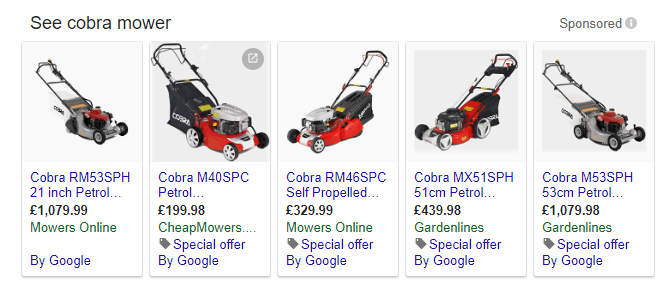How To Make PPC Marketing Work For Ecommerce

9th November 2018
When it comes to ecommerce, PPC marketing (and Google Ads in particular) is an ideal way to get your products in front of the right customer base to grow online sales.
There are a number of paid search tools available which can aid ecommerce. These include:
- Reaching new customers with Google Shopping campaigns
- Retargeting users to encourage them to complete a sale or repeat purchase with Dynamic Remarketing campaigns
- Maximising the returns of PPC campaigns with ROI-led bidding strategies in Google Ads
The real beauty of using paid search for an ecommerce website is that the sales process happens online. This provides full visibility of the customer journey, with detailed data allowing marketers to assess the true impact of their paid search campaigns.
You know:
- How much you have spent
- Where you have spent it
- How much revenue the spend generated
- Which products generated the revenue
You have so much data from start to end, as does Google. This data drives Google’s Machine Learning and AI, which is increasingly used for targeting and bidding optimisation in Google Ads – the more data you have, the greater your potential returns.
Within this blog, I will talk you through three key paid search tools that can be used to market your online retail website - Google Shopping Ads, Dynamic Remarketing campaigns and Target ROAS smart bidding strategies.
Google Shopping Ads
Google Shopping ads are a form of PPC marketing campaign that displays products in Google search results, rather than just a text-based ad. Unlike Search campaigns, which target search phrases using keywords, Shopping campaigns use items within a product feed to display relevant search results to users on Google – for example:

If you have thousands of products on your website, it’s likely that you are already using a product feed. If you are, you’ve done the hard part – now you can use this data in Google Ads to target users who are looking for your specific products.
When it comes to our ecommerce clients, shopping ads typically drive over 50% of the PPC sales. With these figures in mind, it’s worth putting the effort in to creating a product feed for your website and adding it to Google Merchant Centre for paid marketing use.
If you’re competitively priced, which doesn’t necessarily mean the cheapest, Shopping ads work in our experience because people get an indication of the product before they have even clicked on the ad. The product name, image and price are all readily available in Google search results for the user to digest prior to clicking on an ad, which may improve the quality of traffic to your ecommerce website.
That’s not to say that online retailers should just be using Shopping Ads – our view is that they exist to complement Search campaigns rather than to replace them. A combination of Search campaigns and Shopping Ads campaigns can be used to maximise visibility in search results and capture high-value users who are ready to buy from your website.
Dynamic Remarketing
Be honest – how many times have you been chased round the internet by the shoes of your dreams, or the weekend break in Paris you checked out whilst watching petit four week on the Great British Bake Off? Those ads are dynamic display remarketing ads – a form of targeting where what you’ve seen on a website influences what you see off it.

As marketers, the data available to us allows us to understand how you interact with websites. We often know:
- How long you spend on a website
- Which pages you have viewed on a website
- If you are a new or returning visitor
- Which products you have purchased
When used in line with paid search campaigns, that’s the reason you get shown display adverts for that car or those shoes – especially that pair you have viewed six times this week!
Using this data, we can create dynamic ads specific to the products that a website visitor has viewed or bought. These tailored ads can improve both customer experience and increase new sales as well as repeat purchases for the online retailer.
Of course, we may not want to target you with ads at all! As marketers, understanding who to avoid targeting is as crucial as understanding who to target in the first place. There will be more of a focus on the high margin products - those with improved return on investment.
And all these decisions lead to smarter advertising choices, a bigger bottom line and an improved ROI.
Smart Bidding Strategies
If you are seeing larger numbers of visitors to your websites then Google’s Dynamic Campaigns, Machine Learning and AI intelligence really come into their own.
Google has access to millions of data signals, which its algorithms can analyse and act upon in ways mere humans simply couldn’t. The more data Google has the better - its dynamic and automated features thrive on data.
A key component of this is automated bidding strategies, which use Google’s algorithmic data alongside your bids to target users in a method called Smart Bidding.
Smart bidding helps to optimise your bids for every search auction in real-time, based on Google’s Signals. Google can increase or decrease bids depending on how likely a user will be to purchase from your website, using a combination of user data your historical account data.
The automatic adjustment of bids can save you both time and money when managing PPC campaigns – Google can bid aggressively for users who are likely to purchase, whilst scaling back spend on those who aren’t. This can improve spend efficiency and, ultimately, ROI.
There are so many smart ways of bidding – gone are the days of relying on Manual CPC bids.
One particular bid strategy related to Shopping campaigns is Target ROAS, a strategy allowing you to set a target return on ad spend percentage for your Shopping campaigns.
Google Ads uses your data to predict future product sales and revenue based on your historic conversion values in your Shopping campaigns. The platform then sets bids to maximise potential revenue at an average ROAS that aligns with your percentage target.
To begin using this bid strategy, Google specifies the following criteria:
"To use Target ROAS bidding, your campaign must have at least 15 conversions in the past 30 days. To maximise results and give machine learning algorithms enough data to make informed bidding decisions, we recommend that you have at least 50 conversions in the past 30 days. It also helps if your campaign has received conversion values at a similar rate for at least a few days."
Further details on Target ROAS can be found in the Google Ads Help Centre.
To summarise, there are various PPC marketing tools available for ecommerce websites to grow sales and maximise returns. With Google Ads providing the capability to target users who are ready to buy, PPC is a great choice for online retailers to drive sales and revenue.
If you would like further help with marketing your ecommerce business online, contact us online today or call us on 01536 316100.






